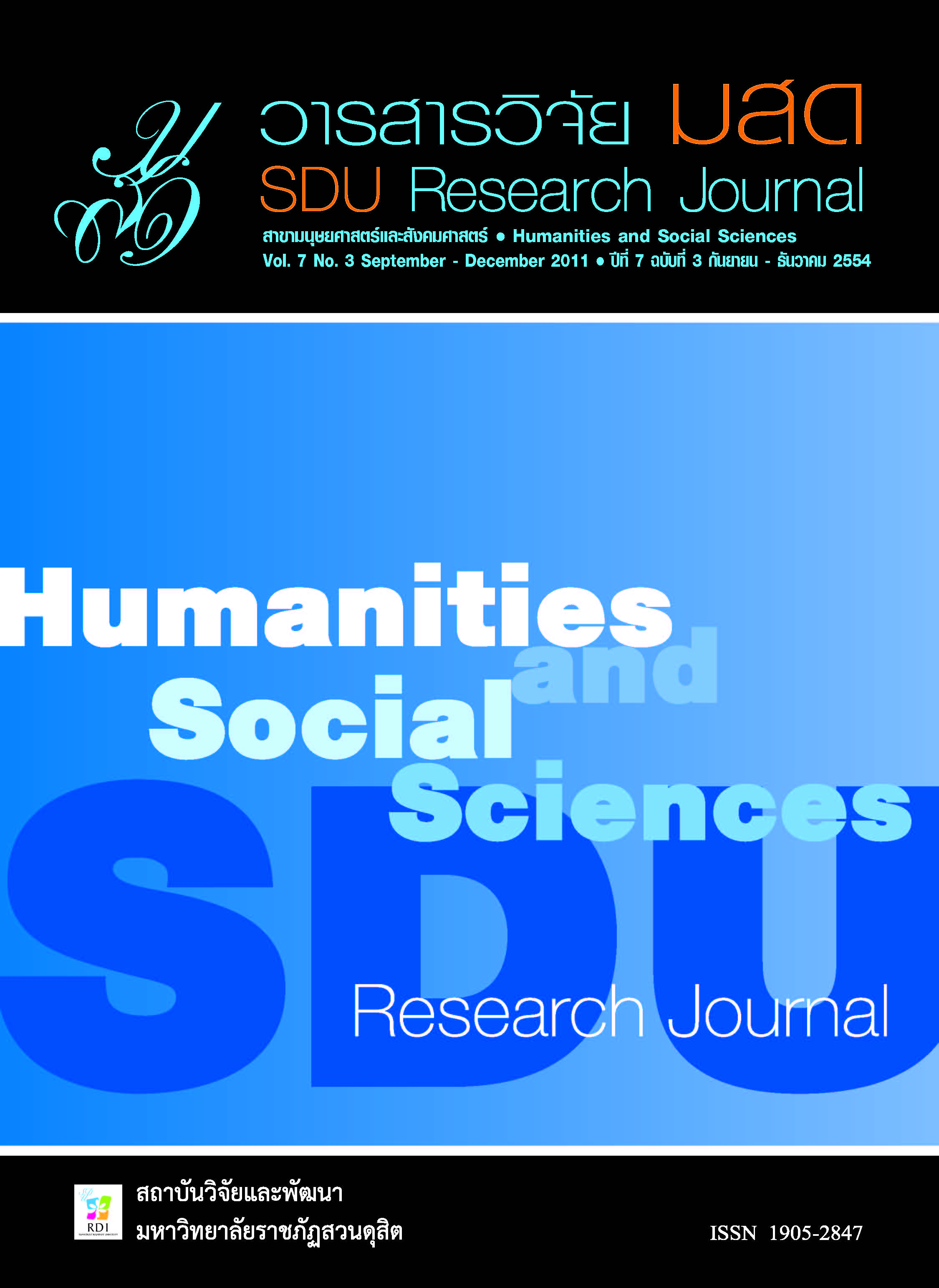การพัฒนาแบบวัดทักษะการคิดขั้นสูงสำหรับนักเรียนมัธยมศึกษาตอนต้น
Keywords:
ทักษะการคิดขั้นสูง, แบบวัด, นักเรียนมัธยมศึกษาตอนต้น, Higher-order thinking skill test, Lower secondary school studentsAbstract
บทคัดย่อ
บทคัดย่อ การวิจัยครั้งนี้มีวัตถุประสงค์ 3 ประการ คือ ประการแรก เพื่อสร้างแบบวัดทักษะการคิดขั้นสูง ประการที่สอง เพื่อตรวจสอบคุณภาพของแบบวัดทักษะการคิดขั้นสูง และประการที่สาม เพื่อสร้างเกณฑ์ปกติวิสัย (norms)ของแบบวัดทักษะการคิดขั้นสูง สำหรับนักเรียนมัธยมศึกษาตอนต้น ประชากรเป็นนักเรียนมัธยมศึกษาตอนต้น ปีการศึกษา 2553 ของโรงเรียนมัธยมศึกษา สำนักงานเขตพื้นที่การศึกษานครสวรรค์ เขต 1 จำนวน 11,146 คน กลุ่มตัวอย่างเป็นนักเรียนมัธยมศึกษาตอนต้น จำนวน 6,000 คน ได้มาจากการสุ่มตัวอย่างแบบแบ่งชั้นภูมิ เครื่องมือที่ใช้ในการวิจัย ประกอบด้วย1) แบบวัดการคิดวิเคราะห์ 2) แบบวัดการคิดวิจารณญาณ 3) แบบวัดการคิดตัดสินใจ และ 4)แบบวัดการคิดแก้ปัญหา วิเคราะห์ค่าพารามิเตอร์ข้อสอบ ด้วยโปรแกรม MULTILOG ตรวจสอบความตรงตามโครงสร้างโดยใช้การวิเคราะห์องค์ประกอบเชิงยืนยัน และวิเคราะห์ความเที่ยงของแบบวัดโดยใช้สูตรสัมประสิทธิ์แอลฟา (α = Coefficient) ของครอนบาค
ผลการวิจัย พบว่า
1. ผลการวิเคราะห์ค่าพารามิเตอร์ข้อสอบ มีค่าดังนี้ แบบวัดการคิดวิเคราะห์ จำนวน 55 สถานการณ์ มีค่าอำนาจจำแนกอยู่ระหว่าง 0.54 ถึง 2.33 ค่าความยากอยู่ระหว่าง -2.27 ถึง 2.06 ค่าการเดาอยู่ระหว่าง 0.00 ถึง 0.27 แบบวัดการคิดวิจารณญาณ จำนวน 50 สถานการณ์ มีค่าอำนาจจำแนกอยู่ระหว่าง 0.50 ถึง 2.39 ค่าความยากอยู่ระหว่าง -2.14 ถึง 2.35 ค่าการเดาอยู่ระหว่าง 0.00 ถึง 0.30 แบบวัดการคิดตัดสินใจ จำนวน 52 สถานการณ์ มีค่าอำนาจจำแนกอยู่ระหว่าง 0.50 ถึง 2.11 ค่าความยาก อยู่ระหว่าง -2.35 ถึง 2.16 ค่าการเดาอยู่ระหว่าง 0.00 ถึง 0.30 แบบวัดการคิดแก้ปัญหา จำนวน 62 สถานการณ์ มีค่าอำนาจจำแนกอยู่ระหว่าง 0.57 ถึง 2.42 ค่าความยากอยู่ระหว่าง -2.49 ถึง 1.42 ค่าการเดา อยู่ระหว่าง 0.00 ถึง 0.07
2. ผลการตรวจสอบคุณภาพของแบบวัดทักษะการคิดขั้นสูง โดยการหาค่าความเที่ยงของแบบวัดทักษะการคิดขั้นสูง พบว่า แบบวัดการคิดวิเคราะห์มีค่าความเที่ยง เท่ากับ 0.61 แบบวัดการคิดวิจารณญาณ มีค่าความเที่ยงเท่ากับ 0.81 แบบวัดการคิดตัดสินใจ มีค่าความเที่ยงเท่ากับ 0.84 แบบวัดการคิดแก้ปัญหามีค่าความเที่ยงเท่ากับ 0.73 และผลการตรวจสอบความตรงตามโครงสร้างของแบบวัดทักษะการคิดขั้นสูง โดยใช้การวิเคราะห์องค์ประกอบเชิงยืนยัน ข้างต้นมีความตรงเชิงโครงสร้างเนื่องจากดัชนี GFI และ AGFI เข้าใกล้ 1 หรือดัชนี RMR เข้าใกล้ 0
3.ผลการสร้างเกณฑ์ปกติระดับท้องถิ่น ในรูปคะแนน ที ของแบบวัดการคิดวิเคราะห์ อยู่ในช่วง T16 – T65 แบบวัดการคิดวิจารณญาณ อยู่ในช่วง T13 – T65 แบบวัดการคิดตัดสินใจ อยู่ในช่วง T16 – T61และแบบวัดการคิดแก้ปัญหา อยู่ในช่วง T17 – T59
คำสำคัญ : ทักษะการคิดขั้นสูง, แบบวัด, นักเรียนมัธยมศึกษาตอนต้น
Abstract
The objectives of this research were 1) to develop testing models of higher-order thinking skills for lower secondary school students; 2) to investigate the quality of higher-order thinking skill tests, and 3) to provide norm criteria of higher-order thinking skill tests for lower secondary students.
The research population was drawn from 11,146 students from lower secondary school of the Nakhon Sawan Educational Service Area 1 in the 2010 academic year. The samples were 6,000 students in secondary school selected by stratified sampling. The research instruments consisted of 1) analytical thinking tests; 2) critical thinking tests; 3) decision thinking tests, and 4) problem thinking tests. The item parameter was analyzed through the MULTILOG program. Construct validity was validated using Confirmatory Factor Analysis. Validity was analyzed using Cronbach’s Alpha Coefficient.
The research findings were as follows:
1. The analysis of the item parameter revealed that for the analytical thinking tests on 55 situations, the discrimination was found to be from 0.54 to 2.33. The difficulty was found to be from -2.27 to 2.06. The guessing was to be from 0.00 to 0.27. As for critical thinking tests on 50 situations, the discrimination was found to be from 0.50 to 2.39. The difficulty was found to be from -2.14 to 2.35. The guessing was found to be from 0.00 to 0.30. Concerning the decision thinking tests on 52 situations, the discrimination was found to be from 0.50 to 2.11. The difficulty was found to be from -2.35 to 2.16. The guessing was to be from 0.00 to 0.30. For the problem thinking tests on 62 situations, the discrimination was showed to be from 0.57 to 2.42. The difficulty was found to be from -2.49 to 1.42. The guessing was found to be from 0.00 to 0.07.
2. The reliability of the higher-order thinking tests revealed that the reliability of analytical thinking tests was 0.61, the reliability of critical thinking tests was 0.81, the reliability of decision thinking tests was 0.84, the reliability of problem thinking tests was 0.73 and the construct validity of the higher-order thinking skill tests by using Confirmatory Factor Analysis revealed that the GFI and AGFI indexes were close to 1 or RMR index was close to 0.
3. The local norms in T score revealed that the analytical thinking tests were showed at T16-T65, the critical thinking tests at T13-T65, the decision thinking tests at T16-T61, and the problem thinking tests at T17-T59.
Keywords : Higher-order thinking skill test, Lower secondary school students








